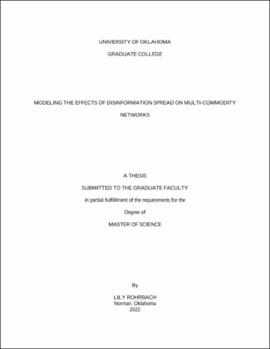| dc.contributor.advisor | Barker, Kash | |
| dc.contributor.author | Rohrbach, Lily | |
| dc.date.accessioned | 2022-05-03T20:05:34Z | |
| dc.date.available | 2022-05-03T20:05:34Z | |
| dc.date.issued | 2022-05 | |
| dc.identifier.uri | https://hdl.handle.net/11244/335485 | |
| dc.description.abstract | Disinformation has become a more common weapon amidst growing social media platforms and users, targeting consumer behavior to affect physical infrastructure. Understanding how disinformation could attack a multi-commodity network and how to minimize its spread will help alleviate stress on systems during attacks. This research integrates an epidemiological model (SIR) with a mixed integer programming (MIP) model to minimize weighted shortage across commodities, evaluating the change over time dependent on disinformation spread β and recovery γ. It is then applied to a multi-commodity Swedish railway network carrying 14 goods over 200 nodes. Results demonstrated how different spread and recovery rates change the degree and timing of shortage. | en_US |
| dc.language | en_US | en_US |
| dc.subject | disinformation | en_US |
| dc.subject | multi-commodity | en_US |
| dc.subject | SIR | en_US |
| dc.subject | mixed integer programming | en_US |
| dc.title | Modeling the Effects of Disinformation Spread on Multi-Commodity Networks | en_US |
| dc.contributor.committeeMember | Zhu, Rui | |
| dc.contributor.committeeMember | Gonzalez Huertas, Andres | |
| dc.date.manuscript | 2022 | |
| dc.thesis.degree | Master of Science | en_US |
| ou.group | Gallogly College of Engineering::School of Industrial and Systems Engineering | en_US |
